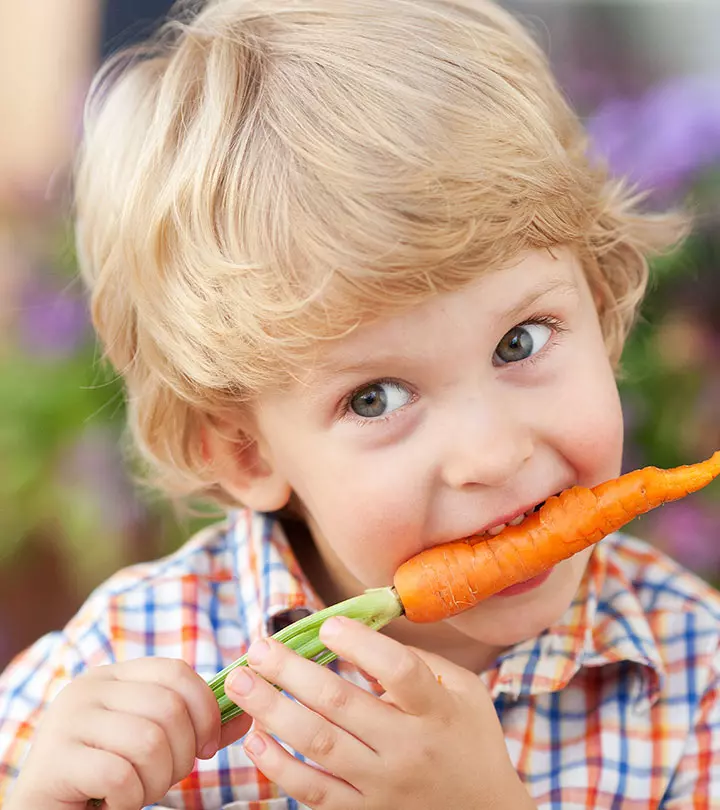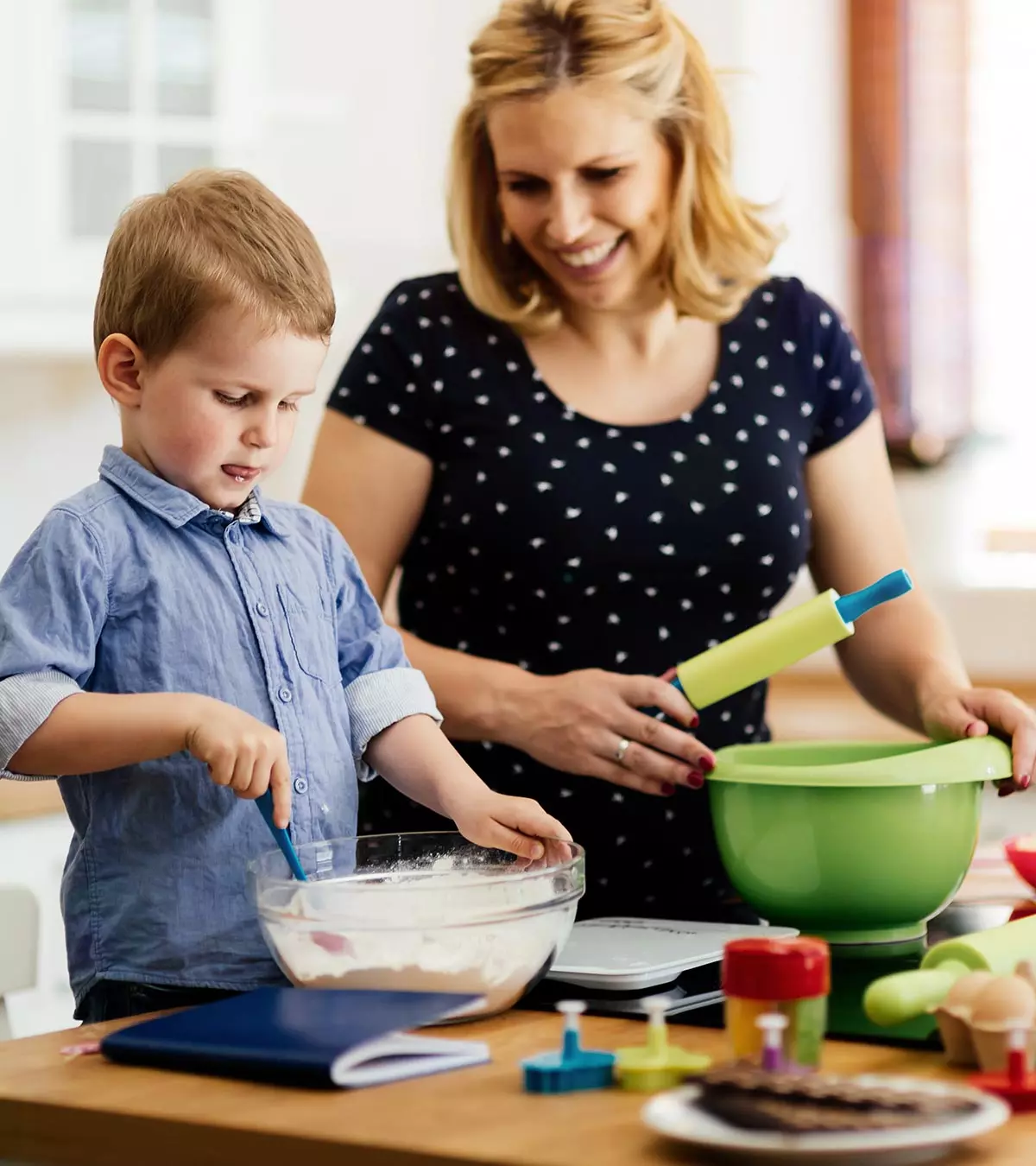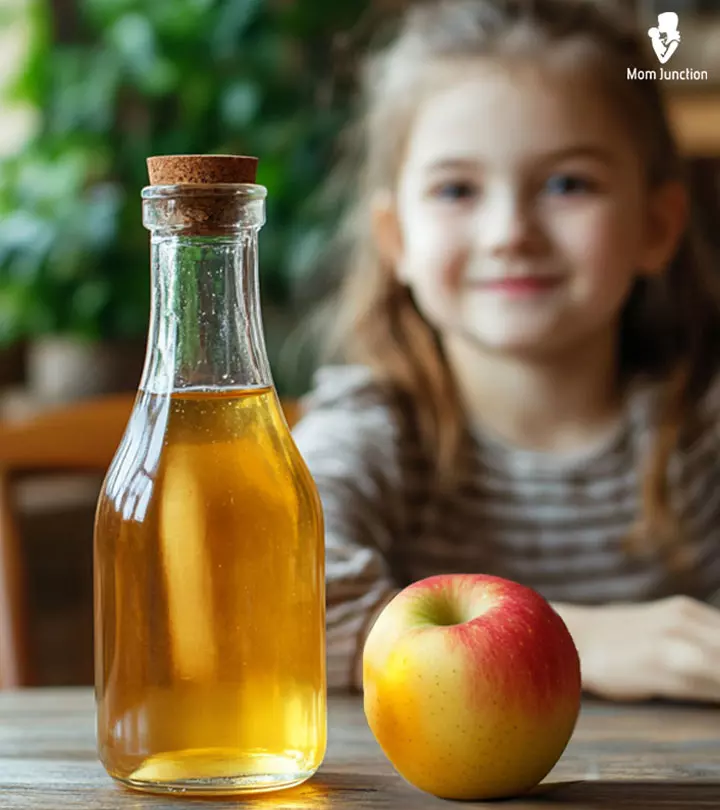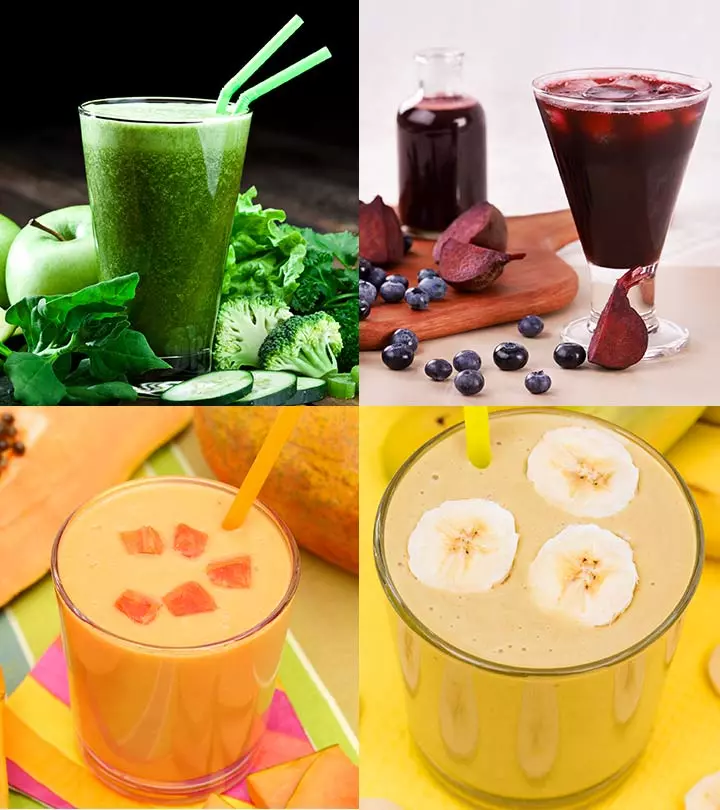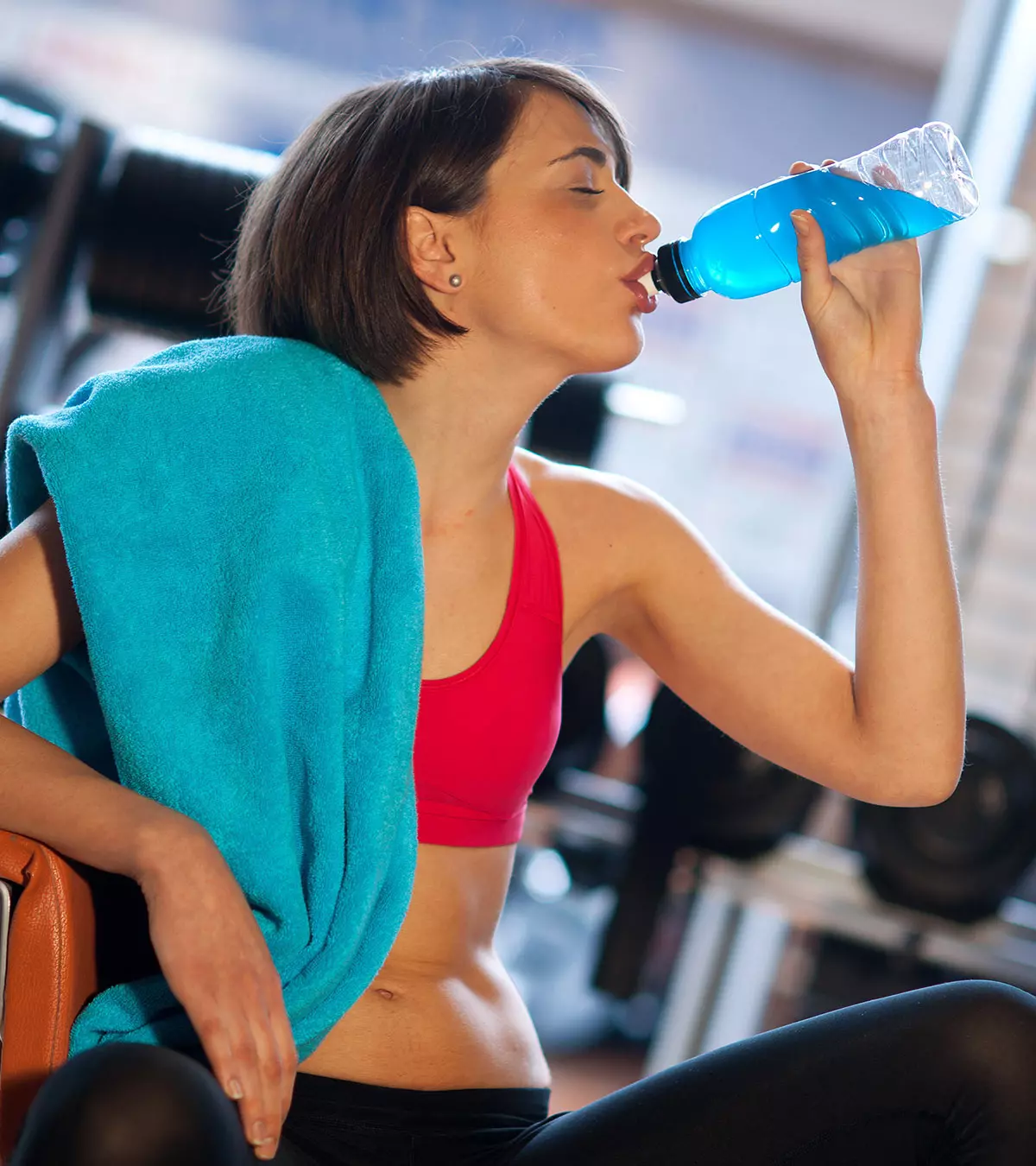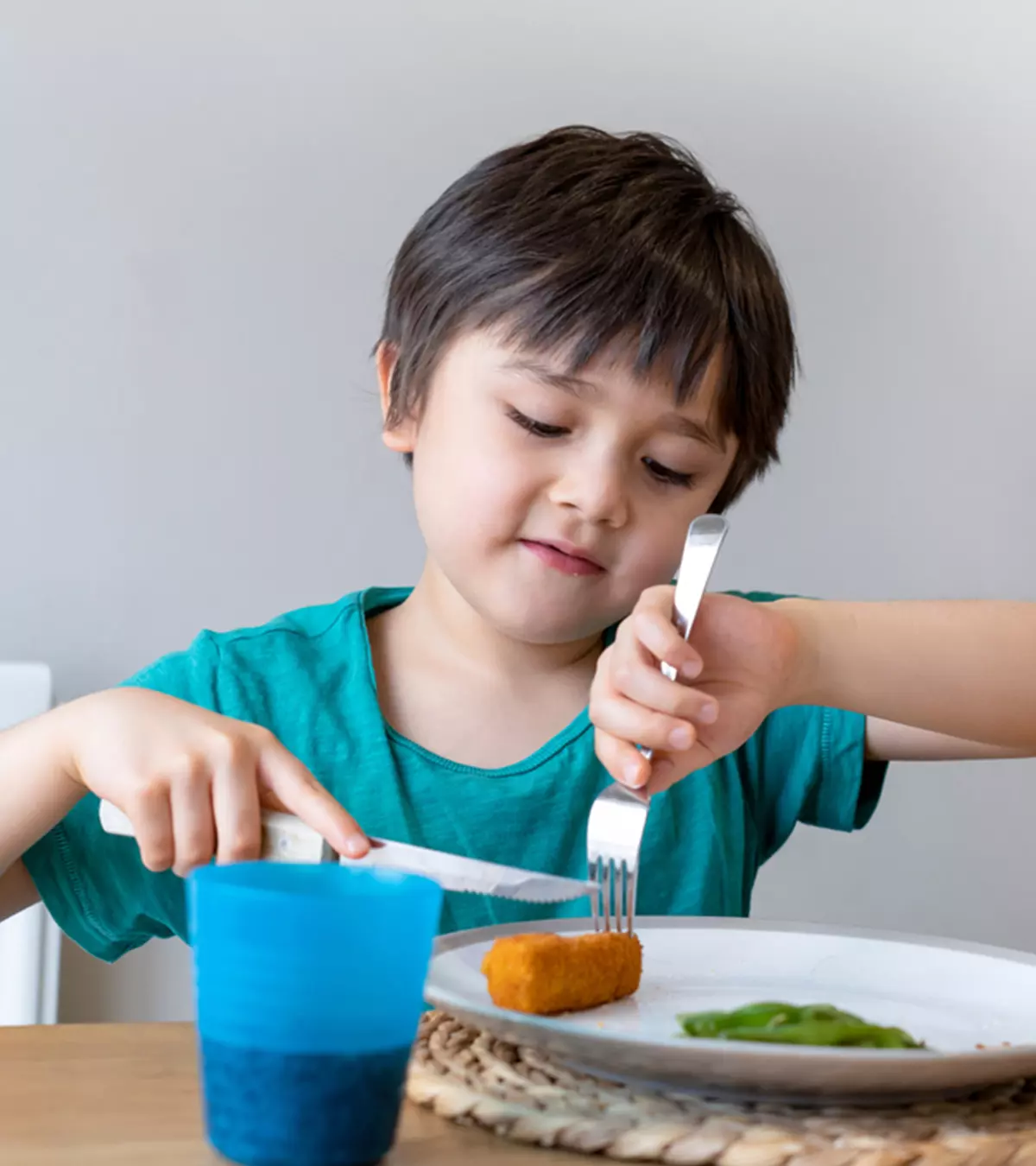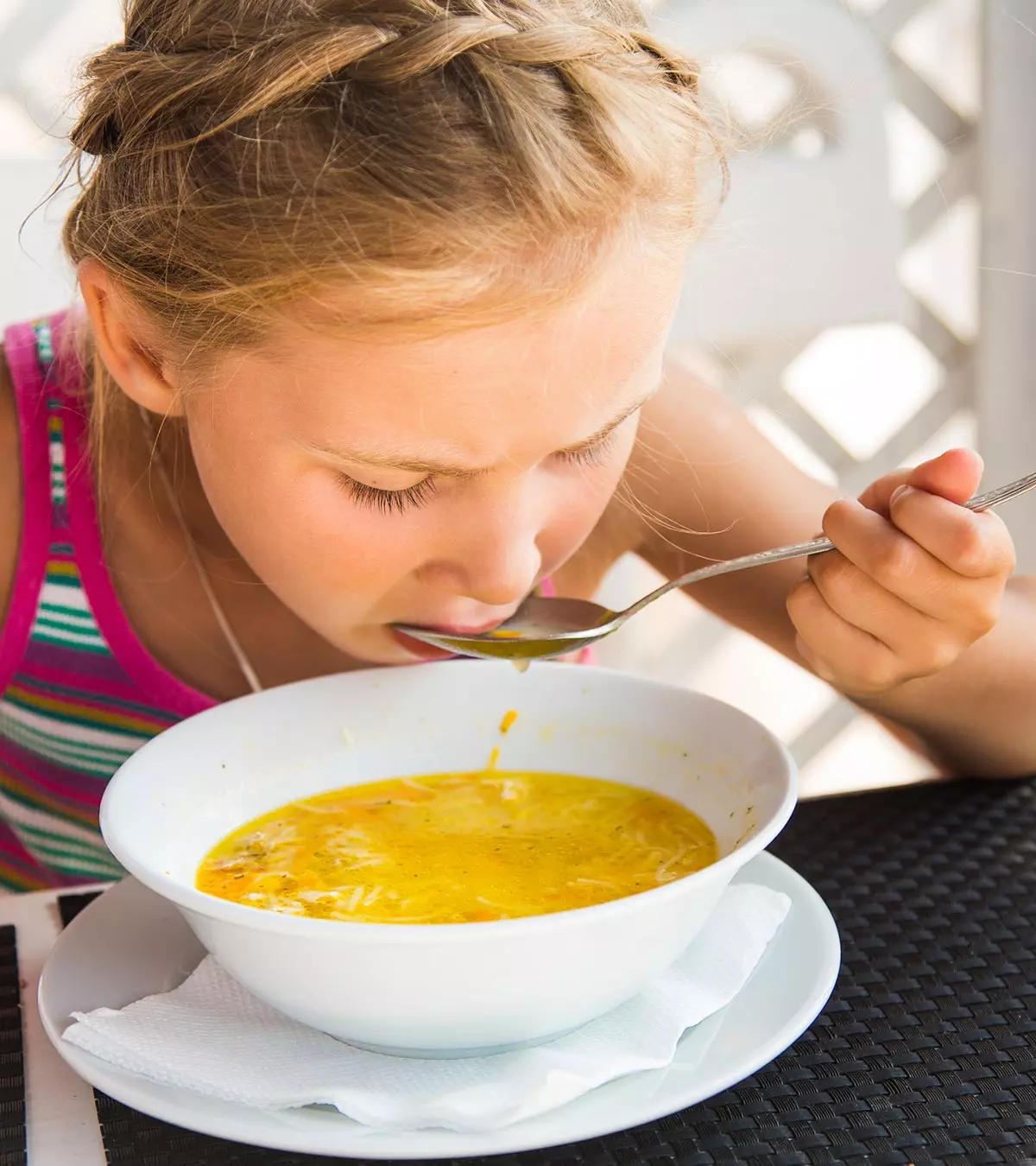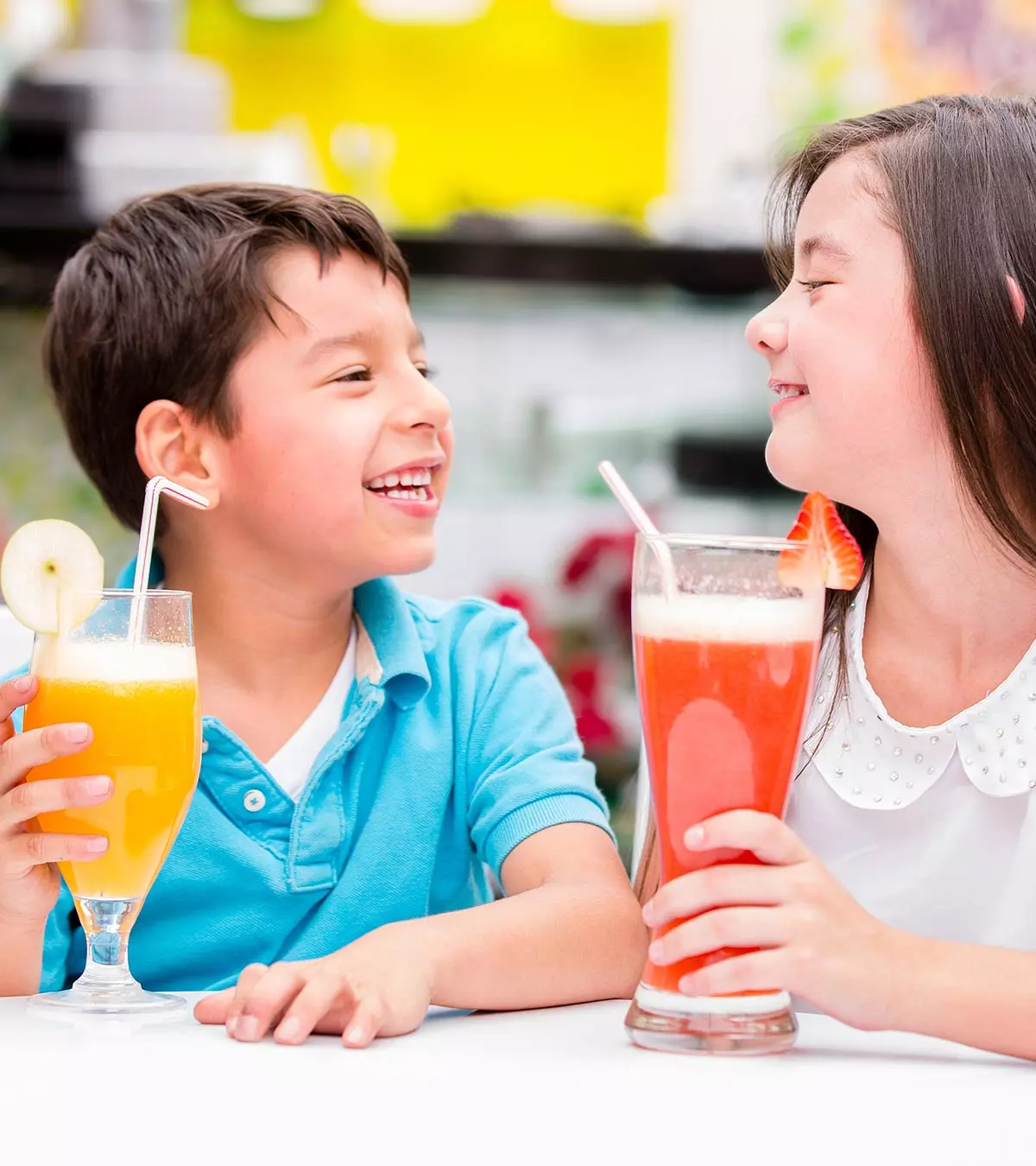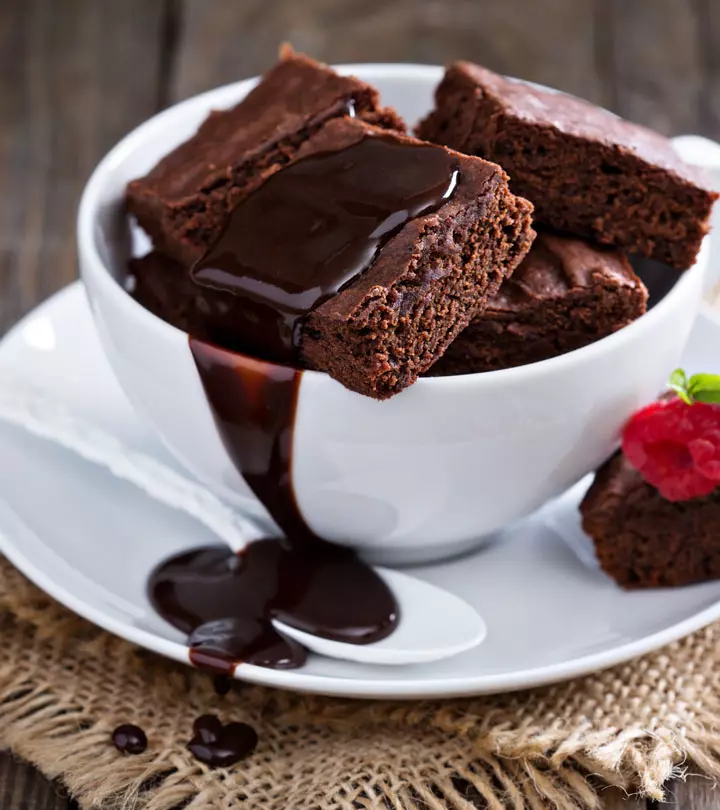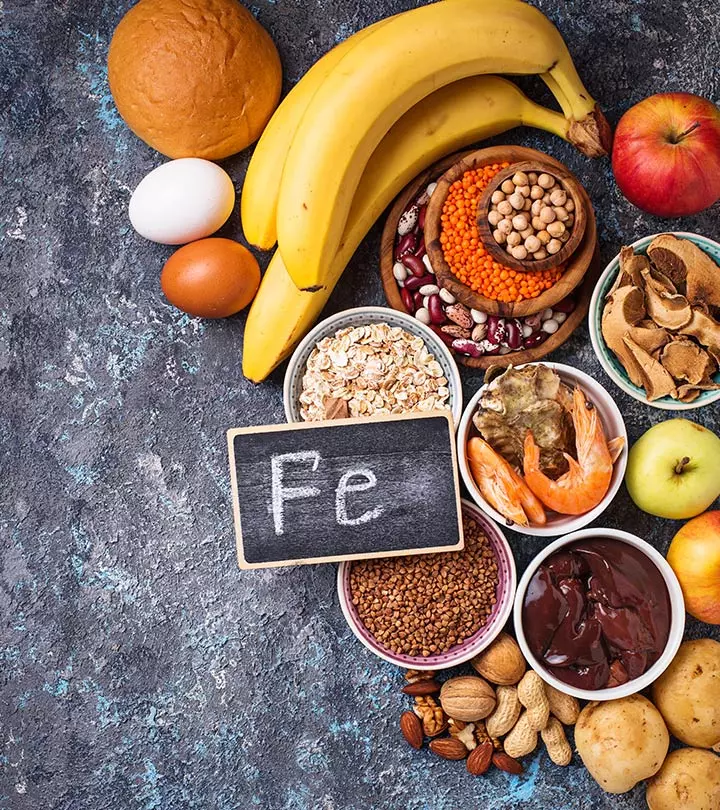
Image: Shutterstock
Choosing healthy, iron-rich foods for kids and adding them to their meals is essential. Iron is a vital nutrient growing children need for several physiological functions, such as brain development. Most healthy children can fulfill their daily iron needs from a well-balanced diet.
Yet, iron deficiency among children is common and can evolve into iron deficiency anemia (IDA) According to the Pan-American Health Organization (PAHO), the regional prevalence of anemia in the US among children aged between six and 59 months was about 16.5%, amounting to about 12 million children. When neglected for a prolonged time, iron deficiency anemia can affect a child’s growth and cause learning or behavioral problems, affecting their quality of life (1).
Read on as we tell you about the functions of iron and the nutritious, iron-rich foods children can safely consume.
Key Pointers
- Iron is required for normal brain development and cognitive function in children.
- The recommended iron intake for teenagers is 11 mg/day for boys and 15 mg/day for girls.
- Meat, poultry, and seafood are animal-origin foods rich in heme iron.
- Serving non-heme iron foods with vitamin C-rich foods can enhance its bioavailability.
Why Is Iron Important For Children?
Iron performs several functions in the body, such as the production of blood cells (hematopoiesis). It also performs the following functions (2).
- Binds to globin protein and forms hemoglobin that transports oxygen from the lungs to the entire body
- Enables metabolism and converts blood glucose or sugar into energy
- Supports production of certain hormones
- Acts as a component of certain enzymes involved in collagen production, and synthesis of some neurotransmitters
- Facilitates proliferation and maturation of immune cells and supports immune system functioning
Also, iron is crucial for the proper brain development and cognitive functioning of a child.
How Much Iron Do Children Need?
Knowing your child’s daily iron needs is crucial to prevent its deficiency and excess. Here’s how much iron a child needs for their age (3).
| Age (years) | RDA (mg/day) |
| 1 to 3 | 7 |
| 4 to 8 | 10 |
| 9 to 13 | 8 |
| Adolescent boys (14 to 18) | 11 |
| Adolescent girls (14 to 18) | 15 |
Source: Dietary Guidelines For Americans 20120-2025
Excess iron or iron overload is as harmful as iron deficiency. When a child has excess iron, their body stores the extra iron in different organs, such as the liver, heart, and endocrine glands (4). Chronic iron deposition can cause life-threatening diseases and disorders over time. Excess iron in children due to dietary intake is highly unlikely. Nevertheless, it is good to know the right amount of iron your child needs and from where you can get it.
 Quick fact
Quick factWhat Foods Are Rich In Iron?
Consuming various foods from different food groups is the best way to provide sufficient iron to prevent iron deficiency anemia in toddlers. Food offers two types of iron, heme and non-heme iron. Depending on your dietary habits (vegetarian, non-vegetarian, or vegan), you can select nutrient-dense, iron-rich foods from the following list.
Heme Iron-Rich Foods
Animal-origin foods, such as meat, poultry, and seafood, are a good source of heme iron. Heme iron is more bioavailable than non-heme iron and has an absorption rate of about 20 percent, irrespective of how you prepare and serve the food (5). Here are some heme iron-rich foods you can add to your child’s diet.
- Duck breast (skinless): Duck breast (skinless) is a nutrient-dense lean meat you can serve as part of a well-balanced diet. On average, 83g of duck breast with bones and skin removed can provide around 3.74mg iron, 16.4g protein, and 222mg potassium with other vital nutrients (6).
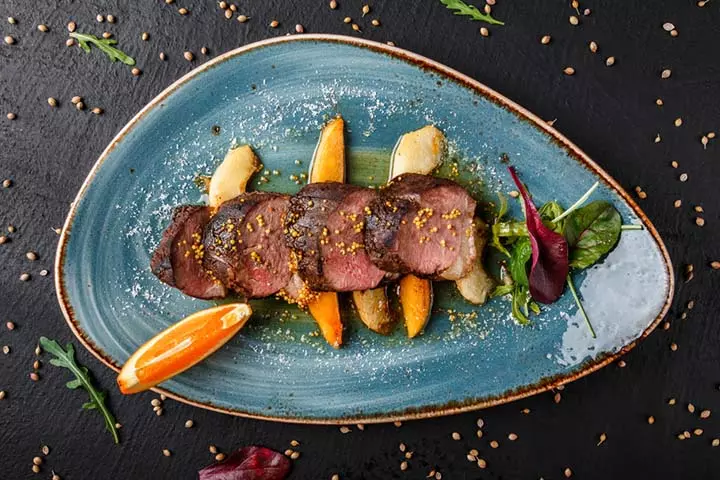
- Lean beef: Beef refers to cattle meat, which is the richest heme-iron source. Besides, it can provide high-quality protein, B vitamins, zinc, and selenium (7). However, regular consumption of red meat is linked to several health risks, such as heart disease. Hence, you should add only lean beef cuts to your child’s diet. Serving 100g of 80 percent ground lean beef can provide 17.2g protein, 1.94mg iron, and 270mg potassium with other vital nutrients (8).
- Turkey egg: One turkey egg (79g) can offer 135 calories, 10.8g protein, 3.2g of iron, and several other nutrients, such as selenium and phosphorus (9). In contrast, one hen’s egg (63g) can provide 7.9g protein and 1.1mg of iron with other essential nutrients (10). Try including turkey egg in your child’s diet along with other iron-rich foods.
- Chicken liver: If your child doesn’t like eating beef and pork, serve them lean poultry, such as the chicken liver instead. Chicken liver is an iron-rich food that can offer 9.2mg of iron per two and a half ounces (75g) of serving (11). Besides, it can provide high-quality protein, vitamin A, vitamin B2, vitamin B12, choline, and copper.
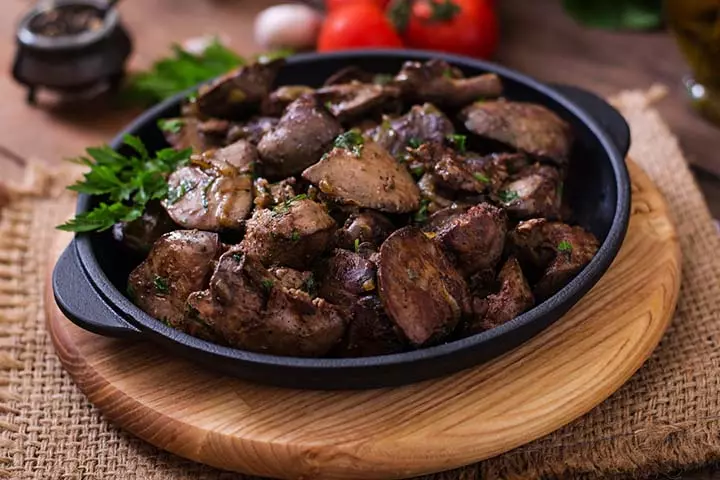
- Seafood: Seafood can offer a significant amount of high-quality lean protein, omega-3 fatty acids, vitamin D, vitamin E, and vitamin B. On average, three ounces (85g) of salmon fish (Atlantic, raw, wild), tuna (fresh, yellowfin), and shrimp (raw) can provide 0.68mg, 0.65mg, and 1.8mg iron, respectively (12) (13) (14). Some other seafood children can enjoy in moderation to get more iron are crab, clam, oyster, and mussels.
Non-Heme Iron-Rich Foods
Non-heme iron is less easily absorbed than heme iron. However, you can enhance its bioavailability by serving non-heme iron foods with vitamin C-rich foods, such as citrus fruits, vitamin C-rich veggies like tomatoes or bell peppers and fortified orange juice (12).
- Dark green leafy vegetables
Spinach, broccoli, bok choy, asparagus, Brussels sprouts, and romaine lettuce are a few dark green veggies that can provide sufficient iron and several micronutrients to your child. Experts advise children between two and 18 years to consume one to three cups of veggies each day. Curries, soups, casseroles, sandwiches, and wraps are dishes that can help you add plenty of veggies to your child’s meals. - Dried fruits
Dried fruits, such as prunes, raisins, apricots, figs, and dates, are nutrient-dense foods that can provide a significant amount of iron. Children between two and eight years need around 1 to 2 cups of fruits in a day (15). You may add half a cup of dried fruits to your child’s daily diet (equivalent to one cup of fruits) to provide them with sufficient amounts of iron.
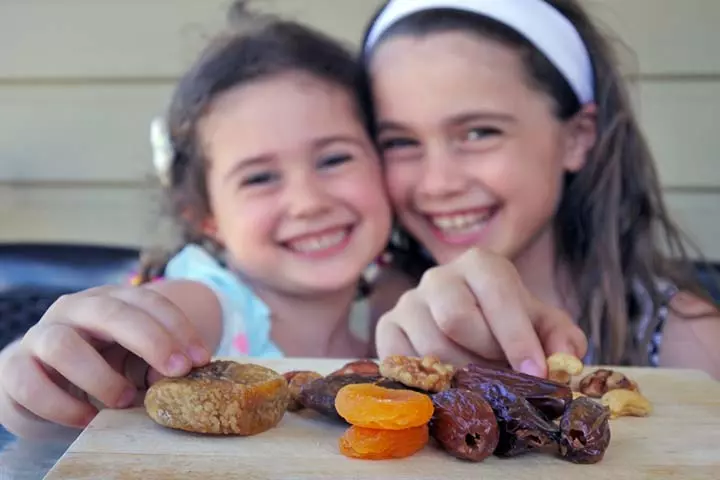
- Soy foods
Soy or soybean is a protein-dense food that contains high amounts of iron. According to USDA, half a cup of cooked soybeans can offer 4.4 mg iron (12). Experts advise consuming fermented soy products, such as tofu and tempeh, as fermentation increases the iron’s bioavailability from soybeans. - Beans
Beans and lentils are protein-dense foods that can give your child a high amount of iron per serving. For instance, one cup of cooked lima beans can provide 4.2 mg iron, whereas half a cup of white beans can give 3.3 mg iron. A cup of cooked green peas can offer 2.5 mg iron, whereas a cup of cooked chickpeas and cowpeas can give 2.4 mg and 2.1 mg iron, respectively (12). - Mushrooms
Mushrooms are edible fungi with a rich nutritional profile. One cup of cooked mushrooms can provide 2.7 mg iron (12). You can prepare mushrooms in different forms and serve them to your child across meals to fulfill their iron needs. - Nuts and seeds
Nuts and seeds, such as cashews, pumpkin seeds, and sesame seeds, contain considerable amounts of iron per serving. For instance, one ounce (approx. 28g) of cashews can offer 1.9 mg iron, whereas half an ounce of pumpkin and sesame seeds can give 2.1 mg iron (12). Feeding whole or chopped nuts and seeds to children younger than four years can be a choking risk. Therefore, stay cautious and preferably feed nuts and seeds to younger children in powder form or as a nut or seed butter in a thinned-out creamy texture. - Whole grains
Whole grains, such as whole oats, whole wheat, quinoa, fortified rice and brown rice, have three parts — bran, germ, and endosperm. Bran is the outermost layer that contains several vital micronutrients, including iron. Feeding a slice of whole wheat bread and a cup of whole wheat spaghetti can provide about one milligram of iron, which can add to your child’s iron needs. - Iron-fortified foods
Iron is used to fortify or enrich several foods, such as breakfast cereals. Half a cup of iron-enriched oatmeal can provide 5 mg iron, while one-fourth cup of fortified bran flakes can provide about 2.8 mg iron, approximately (12). Check food labels carefully and buy iron-fortified cereals, fortified bread, and fortified pasta.
How To Include Iron In Your Child’s Diet?
Here are a few tips to include iron-rich foods in your child’s daily diet.
- Consult a nutrition expert and create a meal plan containing heme and non-heme iron-rich foods. If your child is a picky eater, check with your doctor if they need iron supplementation to fulfill their iron needs. However, remember, most healthy children, eating a well-balanced diet, don’t need iron supplements.
- Read the labels carefully and select iron-fortified foods, such as iron-enriched bread, pizza base, and pasta. It’s vital as cereals usually contain less iron. Fortification is, therefore, the best way to prevent iron insufficiency.

- Compare food labels and pick foods that are a good source of iron. Foods that provide 10 to 19 percent daily value (DV) or more for a nutrient are considered a good nutrient source (16). Remember, the daily values given on the package are for adults, and these values will be higher for children.
- Use cast iron pans and pots for cooking to enhance the iron content of the foods. Also, pair vitamin C-rich foods with non-heme foods to enhance iron absorption. In the same way, you can pair heme iron-rich foods with non-heme iron foods to raise the overall iron content of a meal.
- Avoid over-consumption of milk as the calcium found in milk can interfere in iron absorption and reduce its bioavailability. Similarly, reduce or limit intake of beverages, such as coffee and tea, as they contain tannins, which can also hamper iron absorption.
 Quick fact
Quick factFrequently Asked Questions
1. How do I know if my child’s iron is low?
Pale skin, increased irritability, fatigue, rapid heartbeat, sore or swollen tongue, enlarged spleen, and pica are some signs of iron-deficiency anemia (17). Blood tests can confirm if the child has an iron deficiency.
2. How does iron deficiency affect child development?
Iron-deficiency anemia may cause developmental delays such as decreased social interaction, decreased motor activity, brain function, and reduced attention to tasks. Iron deficiency can also increase the risk of mild to moderate mental retardation (18).
3. Can kids get enough iron from their diet alone?
It is often advised to give children iron-rich foods to meet their nutritional requirements. However, in some cases, children may not get enough iron from dietary sources. As a result, they could be prescribed iron supplements to manage iron deficiency. Your child’s doctor is the best person to advise you on whether iron supplements are required or not. They will also suggest the appropriate dosages depending on your child’s age, health, and dietary habits (17).
4. How can I ensure my child gets enough iron if they are vegetarian?
If you are a vegetarian household, you can focus on giving non-heme iron food sources, including dark leafy greens, beans, dried fruits and nuts, soy foods, and whole grains. Also, make sure to include vitamin C-rich foods, as it enhances iron absorption in the body.
Green leafy vegetables, dried fruits, turkey eggs, and chicken liver are some iron-rich foods for kids. Iron is an essential mineral that is vital in regulating several body functions. Therefore, it is crucial to maintain adequate iron levels in the body. If your child is a vegan, you may serve them plenty of non-heme iron-dense foods and foods rich in vitamin C to improve iron absorption. Nevertheless, if you are apprehensive about your child not getting sufficient iron from foods or spot any signs of iron deficiency in your child, seek an expert opinion.
Infographic: Iron Deficiency And Iron Toxicity In Children
Now that you know the importance of iron and its dietary sources, it can help to know how iron toxicity and iron deficiency can affect your child’s overall health. In this infographic, we shed light on how iron toxicity manifests in kids and behavioral changes that may occur in them due to iron deficiency. Illustration: Momjunction Design Team
Illustration: Healthy Iron-Rich Foods For Kids
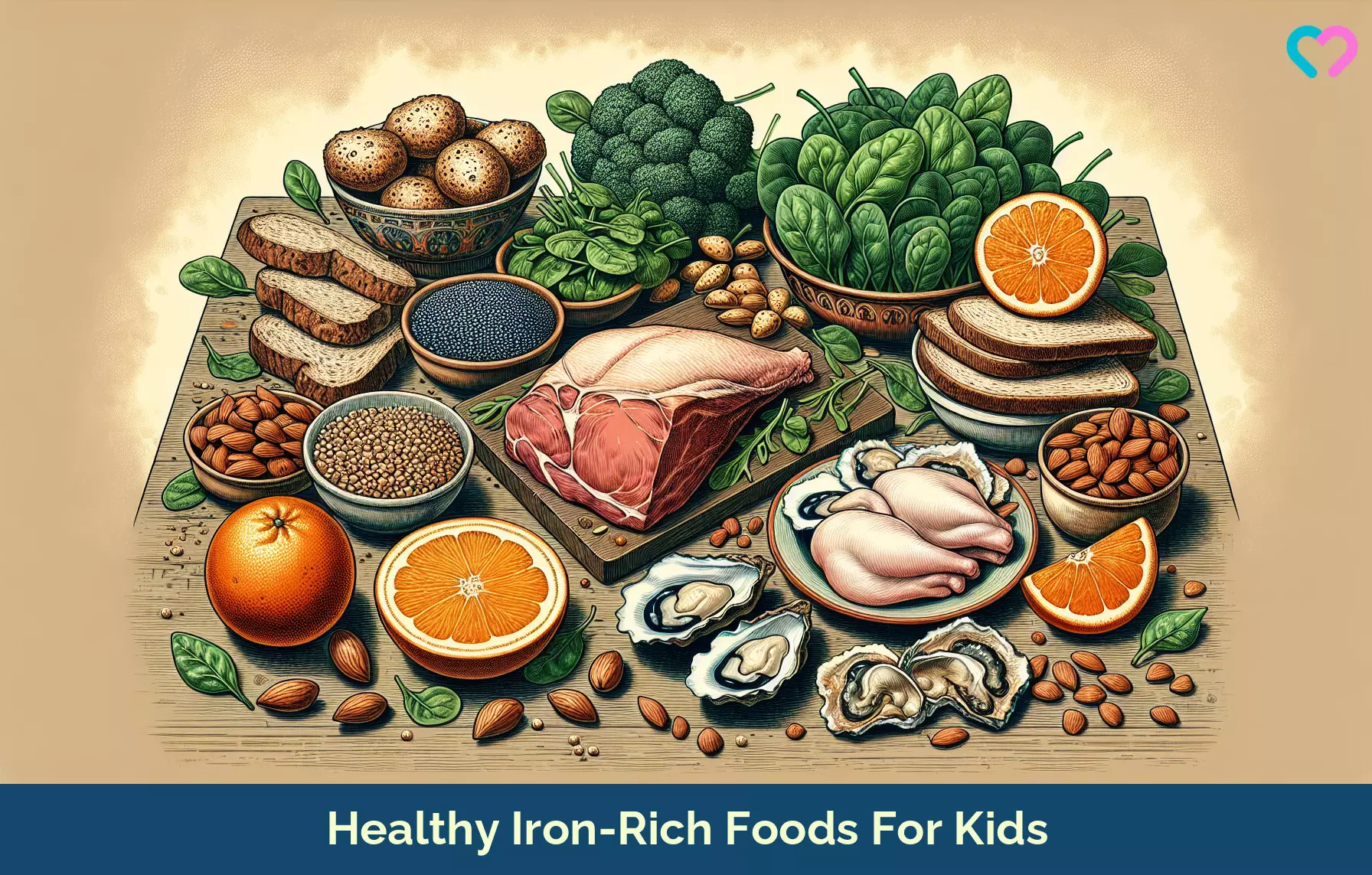
Image: Dall·E/MomJunction Design Team
References
- Iron Deficiency Anemia.
https://www.mottchildren.org/posts/your-child/iron-deficiency-anemia - Hemoglobin and Functions of Iron.
https://www.ucsfhealth.org/education/hemoglobin-and-functions-of-iron - Dietary_Guidelines_for_Americans-2020-2025.
https://www.dietaryguidelines.gov/sites/default/files/2021-03/Dietary_Guidelines_for_Americans-2020-2025.pdf - Lisa A. McDowell et al.; (2021); Iron Overload.
https://www.ncbi.nlm.nih.gov/books/NBK526131/ - Pump Up the Diet with Iron.
https://www.healthychildren.org/English/ages-stages/teen/nutrition/Pages/Pump-Up-the-Diet-with-Iron.aspx - Duck, wild, breast, meat only, raw; FDC ID: 174469.
https://fdc.nal.usda.gov/fdc-app.html#/food-details/174469/nutrients - What’s the beef with red meat?.
https://www.health.harvard.edu/staying-healthy/whats-the-beef-with-red-meat - Beef, ground, 80% lean meat/20% fat, raw; FDC ID: 174036.
https://fdc.nal.usda.gov/fdc-app.html#/food-details/174036/nutrients - Egg, turkey, whole, fresh, raw; FDC ID: 172192.
https://fdc.nal.usda.gov/fdc-app.html#/food-details/172192/nutrients - Egg, whole, raw, fresh; FDC ID: 171287.
https://fdc.nal.usda.gov/fdc-app.html#/food-details/171287/nutrients - Iron in Foods.
https://www.healthlinkbc.ca/healthlinkbc-files/iron-foods - Food Sources of Iron.
https://www.dietaryguidelines.gov/resources/2020-2025-dietary-guidelines-online-materials/food-sources-select-nutrients/food-1 - Fish, salmon, Atlantic, wild, raw; FDC ID: 173686.
https://fdc.nal.usda.gov/fdc-app.html#/food-details/173686/nutrients - Fish, tuna, fresh, yellowfin, raw; FDC ID: 175159.
https://fdc.nal.usda.gov/fdc-app.html#/food-details/175159/nutrients - Healthy eating.
https://www.betterhealth.vic.gov.au/health/healthyliving/healthy-eating - Food labeling.
https://medlineplus.gov/ency/article/002459.htm - Iron-Deficiency Anemia in Children.
https://www.cedars-sinai.org/health-library/diseases-and-conditions—pediatrics/i/iron-deficiency-anemia-in-children.html - Fact Sheets for Families; Iron Deficiency in Early Childhood.
https://cchp.ucsf.edu/sites/g/files/tkssra181/f/IronDeficiency_En_new.pdf - Iron
https://kidshealth.org/en/parents/iron.html - Iron
https://www.cdc.gov/infant-toddler-nutrition/vitamins-minerals/iron.html?CDC_AAref_Val=https://www.cdc.gov/nutrition/infantandtoddlernutrition/vitamins-minerals/iron.html
Community Experiences
Join the conversation and become a part of our nurturing community! Share your stories, experiences, and insights to connect with fellow parents.
Read full bio of Dina Totosegis
Read full bio of Swati Patwal
Read full bio of Rohit Garoo
Read full bio of Dr. Joyani Das








